Liz Withington* and Tiffany Slater examine the impact of the ‘amateur’ geologist on modern scientific research.
In the UK ‘amateur’ geologists have for centuries made significant contributions to our geological knowledge. Without such ‘amateur’ geologists the UK could not boast of its long-standing history in the science of geology.
Our highly technical age has seemingly put these success stories to rest. The image of the ‘amateur’ geologist, clad in walking boots and carrying only a hand lens and rock hammer, is now associated with a bygone era. All of today’s findings, surely, rely on access to specialist equipment such as SEM, x-ray diffractometers, mass spectrometers, and a multitude of other facilities with support technicians, don’t they?
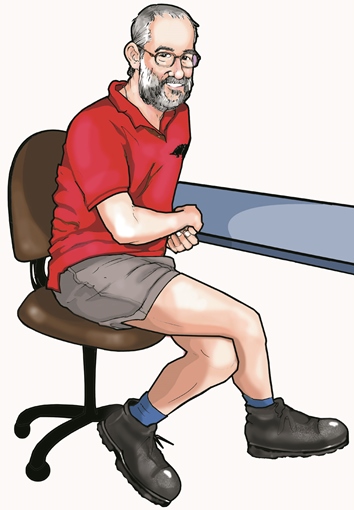
Mike Curtis
Mike Curtis (pictured, right), who died in 2008, was an amateur geologist born in Dursley, Gloucestershire in 1950. He worked as a bus driver, publican, quarryman, and in later life as a soil-testing technician for Geotechnical Engineering Ltd.
Raised in north Bristol, Mike established an early interest in geology as he collected fossils and minerals from the inspiring sites nearby. As an adult, Mike continued to develop his knowledge of the local geology and became increasingly focused on the Rhaetian Period of the Upper Triassic (208-201Ma).
The geological record of the Rhaetian Period shows tumultuous shoreward storms, depositing organic debris across the UK and much of Eastern Europe. This formed concentrated bone beds that were recognised by Mike and his wife Sharon to be of geological significance. In joining Geotechnical Engineering Ltd., Mike recognised that their drilling operations were providing a significant number of samples from the Rhaetian bone beds.
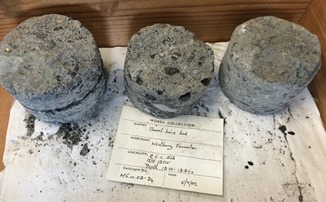 Picture, left: Salvaged fragments of boreholes taken from the Almondsbury interchange, south Gloucestershire.
Picture, left: Salvaged fragments of boreholes taken from the Almondsbury interchange, south Gloucestershire.
While working as a soil technician Mike took a keen interest in the work of engineering geologists. In the area to the north of Bristol, with which Mike was so familiar, Geological Engineering Ltd. was employed to drill boreholes for the erection of gantries along the motorway. As the work was carried out the engineers maintained a log of the soil and rock in the boreholes for the construction industry. Mike recognised the value of these borehole cores, which were destined for landfill. Instead, he saw them as a unique opportunity to study more samples of the Rhaetian bone beds. By careful liaison with the engineering geologists he recovered samples from the cores before they were disposed of. With Sharon’s aid he then meticulously labelled the samples, interpreted the borehole logs, and began acid preparation of the samples.
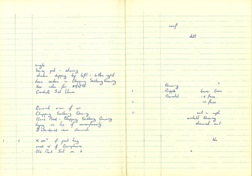 Picture, right: Page from Mike Curtis’ notebook. Photo taken by Tiffany Slater.
Picture, right: Page from Mike Curtis’ notebook. Photo taken by Tiffany Slater.
Dinosaur feet
During his lifetime Mike and Sharon donated part of their collection to the Bristol City Museum and Art Gallery. Following his untimely death, the remainder of the collection was bequeathed to the University of Bristol. The Mike Curtis Collection consists of isolated teeth and fragments of bony fish, sharks, and marine reptiles. The collection also contains highly significant fossils such as remains from the herbivorous dinosaur, Thecodontosaurus. This now serves as the primary collection of material for the ‘At the Feet of the Dinosaurs’ research project, led by Professor Michael J Benton at the University of Bristol.
The project offers select undergraduate students with a strong interest in palaeontology the opportunity to perform palaeontological research. Each student chooses a site from the extensive Mike Curtis Collection and reviews the many unpublished papers written by Curtis. They then study his meticulously prepared and stored samples, identify specimens, count fossil distributions in the samples, and write and illustrate a paper to publication standards.
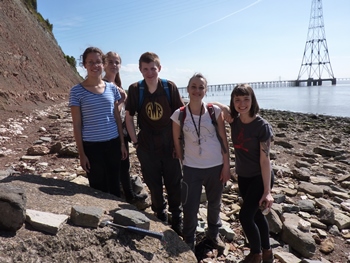 Picture, left: ‘At the Feet of the Dinosaurs’ interns, 2015. L-R: Emma Landon, Emily Hall, Laurence Kinnersley, Valentina Rossi, and Tiffany Slater. Photo: Mike Benton.
Picture, left: ‘At the Feet of the Dinosaurs’ interns, 2015. L-R: Emma Landon, Emily Hall, Laurence Kinnersley, Valentina Rossi, and Tiffany Slater. Photo: Mike Benton.
Tiffany Slater, an undergraduate Biology student, was an intern to the project in 2015 and chose the locality of the Almondsbury interchange. Her role in investigating this unique collection involved quantifying Mike’s microvertebrate collection, taken from the boreholes drilled alongside the motorway. In addition she performed acid digestion of additional boreholes in the University of Bristol’s Palaeobiology lab, sieving and identifying the specimens that were retrieved.
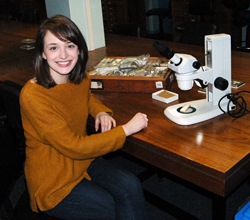 Picture, right: Tiffany Slater analysing contents of the Mike Curtis collection at the University of Bristol. Photo: Hollie Morgan.
Picture, right: Tiffany Slater analysing contents of the Mike Curtis collection at the University of Bristol. Photo: Hollie Morgan.
The boreholes from The Almondsbury interchange exhibited two bone beds, one at the base of the Westbury Formation, and one at the top of the Westbury Formation. Although the occurrence of multiple fossiliferous horizons in the Westbury Formation has previously been reported, events that led to their precise origins were debated. It was previously thought that the bone beds higher in the stratigraphic sequence were a result of reworking of the basal bone bed.
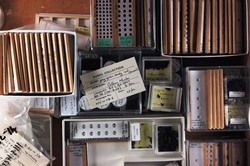 Picture, left: One of the many boxes containing the Mike Curtis collection. Photo: Tiffany Slater.
Picture, left: One of the many boxes containing the Mike Curtis collection. Photo: Tiffany Slater.
Using a combination of Mike Curtis’ detailed stratigraphic annotations of the boreholes and her own work; Tiffany was able to make a number of observations:
- Significant ecological changes were occurring during the Rhaetian, as contents from the top of the formation preserve an ecosystem that is far less biodiverse than that at the onset of the Rhaetian transgressions
- Shark and marine reptile teeth dominate at the base of the Westbury Formation, while teeth from bony fish are abundant at the top of the Westbury Formation
- The sizes of fossils were significantly different for each bone bed, indicating that sediments were deposited in different environments
- Contents of the basal bone bed were not equally represented in the bone bed at the top of the Westbury Formation
Tiffany therefore reached the significant conclusion that the two bone beds originated from separate stratigraphic events, instead of a reworking of the basal bone bed as had previously been thought.
The Mike Curtis Collection has provided Tiffany and many other aspiring palaeontologists the unique opportunity to carry out collaborative research at a professional level. Following this novel work-experience, Tiffany and her contemporaries Emma Landon and Valentina Rossi are now continuing their studies in palaeontology as PhD students.
‘Amateur’ awakening
It is easy to think that the age of the ‘amateur’ geologist is over, and that influential research is now the preserve of those fortunate few who enjoy access to impressive equipment with flashing lights. However an easier access to knowledge and an increase in the affordability of tools and technology has led to a rise of the ‘amateur’ in many fields, creating garage biologists and self-taught photographers. A pair of boots, rock hammer, and hand lens was all that Mike Curtis needed to pioneer research on the biodiversity of the Rhaetian seas.
This should serve as inspiration to the next generation of scientists, who often feel that they must wait for access to ‘cutting edge equipment’ in order for their research to be worthy of publication. Perhaps support of the unbridled curiosity of ‘amateur’ geologists, amid all our technological developments, will pioneer more research, and offer other aspiring young students the opportunity to begin scientific careers.
Further reading
- Benton, M. J. (2016) Palaeobiology Research Group. Available at: http://palaeo.gly.bris.ac.uk/bristoldinosaur/ (Accessed: 1 January 2017).
- Slater, T., Duffin, C. J., Hildebrandt, C., Davies, T. G., Benton, M. J. (2016) ‘Microvertebrates from multiple bone beds in the Rhaetian of the M4-M5 motorway junction, South Gloucestershire, U.K.’ Proceedings of the Geologists’ Association, 127: 464-477.
Author
* Liz Withington (corresponding author): Geotechnical Engineering Ltd, Centurion House, Olympus Park, Quedgeley, Gloucester, GL2 4NF E: [email protected]